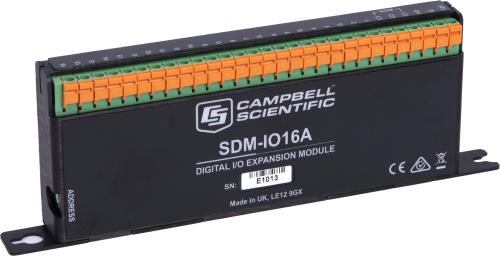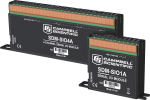






Überblick
Das SDM-IO16 erweitert die Anzahl an digitalen Input- und Output-Kanälen eines Campbell Scientific Datenloggers.
Lesen Sie mehrFunktionen und Vorteile
- 16 digital I/O ports
- When configured as an input, each port can monitor logic state, count pulses, measure signal frequency, and determine duty cycle
- Consumes less than 1 mA power in most applications
- Compact package with spring-loaded, vibration-resistant terminals
- Connects to the data logger via three ports that can be shared with up to 15 other SDM devices
- Multiple different functions for programming each input and different function assignments for different ports on the same module
- Capability of each terminal to directly drive low-voltage valves or relays
- I/O lines protected against high-level surges with gas discharge tubes
Bilder



Technische Beschreibung
When a port is configured as an input, it can measure the logical state of the port, count pulses, and measure the frequency of—and determine the duty cycle of—signals applied to the port. In pulse-counting mode, there is also an option to enable switch-debounce filtering so the unit can accurately count switch-closure events. The SDM-IO16A measures the frequency of signals by measuring the time between pulses, thereby giving relatively high-resolution measurements even for low-frequency signals.
The module can also be programmed to generate an interrupt signal to the data logger when one or more input signals changes state.
When configured as an output, each port can be set to 0 or 5 V by the data logger. In addition to being able to drive normal logic-level inputs, when an output is set HI, a "boost" circuit allows direct control of some low-voltage valves and relays. (Refer to the Specifications section on the web page.)
The SDM-IO16A is a synchronously addressed data logger peripheral. Data logger control ports 1, 2, and 3 are used to address the SDM-IO16A and exchange digital data with it. This module uses advanced error-checking techniques to ensure correct transmission of data to and from the module. Up to 16 SDM-IO16As may be addressed, making it possible to control a maximum of 256 ports from the first three data logger control ports.
Kompatibel mit
Please note: The following shows notable compatibility information. It is not a comprehensive list of all compatible products.
Datenlogger
| Product | Compatible | Note |
|---|---|---|
| CR1000 (retired) | ||
| CR1000X (retired) | ||
| CR3000 | ||
| CR6 | ||
| CR800 (retired) | ||
| CR850 (retired) |
Miscellaneous
| Product | Compatible | Note |
|---|---|---|
| GRANITE 10 | ||
| GRANITE 6 (retired) | ||
| GRANITE 9 |
Additional Compatibility Information
Software Requirements
Support for all the functions requires CRBasic’s SDMIO16 instruction or Edlog’s Instruction 188. Instruction 188 is available in Edlog templates that post date March 2002. (LoggerNet version 2.1 contains this template.) Edlog templates that predate March 2002 can support only the output mode using Instruction 104. The SDMCD16AC instruction supports only the output mode in CRBasic.
Power Considerations
In input mode, the power consumption varies from 3 to 600 microamps depending on the mode and input frequencies. The data logger's rechargeable power supply can often power the SDM-IO16 in these pulse counting or status input applications.
However, when the SDM-IO16 is used in an output mode and is driving significant loads, an external power supply is recommended.
Enclosure Considerations
The SDM-IO16 requires a desiccated, non-condensing environment; a Campbell Scientific enclosure is recommended. An integral mounting bracket, grommets, and screws attach the SDM-IO16 to the backplate of a Campbell Scientific enclosure.
Sensor Cabling
This cabling is typically sold as a part of the sensors. If cabling is not provided, you can use our 9922 two-conductor cable (see Ordering Info). When the distance between the data logger and the SDM-IO16 are significant, verify that the sensor cable has adequate resistance/capacitance specifications. Also, avoid sensors with completion resistors in their pigtails; it's preferable to have the completion resistors at the data logger.
Spezifikationen
| Function | Expands the digital input and/or output capability of a data logger. |
| Operating Temperature | -40° to +70°C |
| Number of Channels | 16 |
| SDM and I/O Port | 0/5 V logic-level ports (for connecting to the data logger’s control/SDM ports) |
| EMC Status | Complies with EN 61326:2013 |
| Operating Voltage | 12 Vdc (nominal 9 to 18 V) |
| Minimum Frequency | 0 Hz is reported if there are less than two high-to-low signal transitions in the measurement interval. |
| Minimum Pulse Width | 244 μs (61.04 μs in high-speed mode) |
| Default Switch Debounce Timing | Input and ground must remain closed for 3.17 ms then remain open for 3.17 ms to be counted as a closure. (0.7925 ms in high-speed mode) |
| Internal Clock Accuracy | ±0.01%, worst case (-40° to +70°C) |
| Maximum Pulse Measurement Interval | 4096 seconds (1024 seconds in high-speed mode) |
| Dimensions | 188 x 64 x 22 mm (7.4 x 2.5 x 0.9 in) |
| Weight | 175 g (6.2 oz) |
Current Drain |
|
| -NOTE- | Current consumption is roughly proportional to input-signal frequency and number of ports used. Current drawn from any output must be added to the quiescent level to obtain the total current drain. |
| Typical Standby | 600 µA (all ports high, no load, excludes pulse counting) |
| Maximum |
|
Maximum Frequency (with 50/50 duty cycle) |
|
| Switch Debounce-Mode Turned Off | 2.0 kHz on all channels simultaneously (8.0 kHz in high-speed mode) |
| Default Switch Debounce-Mode Enabled | 150 Hz on all channels |
Output |
|
| -NOTE- | For information regarding the output current at other voltages, refer to the product manual. |
| ON/HI Voltage (no load) |
|
| OFF/LO Voltage (no load) |
|
| Sink Current | Output will sink 8.6 mA from a 5 V source. |
| Source Current |
|
Input |
|
| Voltage |
|
| Protection | Input clamped at -0.6 V and +5.6 V relative to ground (via a 33 Ω resistor to withstand a continuous current flow of 200 mA) |
| Impedance | Biased to +5 V relative to ground (by a 100 kohm resistor) |
Dokumente
Broschüren Produkte
Übereinstimmung mit Richtlinien u. Vorschriften
Downloads
SDM-IO16A Example Program v.1 (3 KB) 11-08-2020
CRBasic program demonstrating twelve functions of the SDM-IO16A using the SDMIO16() instruction. This program is not an example of a normal operational program, but rather sections may be cut and pasted into other programs with other measurement, control, and data storage functions.



